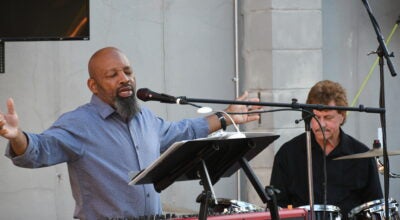Thanking our ‘Greatest Generation’
Published 10:40 am Friday, November 26, 2010
Something was missing from Roger Durbin’s trip to Washington, D.C.; something from the dim yesterdays that cast long shadows of things unspeakable, never forgotten, across his well-worn path.
His sojourn to the nation’s capital back in 1961 made a lasting impression on Durbin, though not in a way you would expect. Of all the historic marvels that dot the District, it was the lack of one that stayed ingrained in the mind of the Berkey, Ohio, (pop. 272) resident.
Durbin, a World War II veteran, had noticed no memorial in place to honor the men and women, at home and abroad, who served during the epic war that has been called the most significant event of the 20th century.
“He was very passionate about it,” recalls Peter Durbin, the only child of Roger and Marian Durbin.
The proud veteran’s concern would gestate for more than a quarter of a century before the first seeds sprouted. In a manner best described as simple and direct, the elder Durbin helped launch what would be, to date, a near-$170 million effort, culminating in his vision for a national memorial to commemorate the victory of freedom over tyranny 56 years ago.
At a Jerusalem Township, Ohio, trustees fish fry in 1986, Durbin boomed a question across a crowded hall in the direction of fellow attendee, Congresswoman Marcy Kaptur.
“He said, ‘Why is there no World War II memorial in Washington?’” remembers Kaptur, a 10-term U.S. Representative from Ohio’s 9th District.
“I said, ‘Well, sir, there is—Iwo Jima.’ He said, ‘Wrong. That’s to one service (Marines), one battle.’ I walked across to him and said, ‘Talk to me about this.’ He said he had wanted to take his grandchildren to the memorial in Washington and when he got there, there wasn’t any.”
Kaptur initially introduced legislation for the World War II Memorial in 1987. Her attempts to get Congress to act on the proposal failed repeatedly over the ensuing six years, but Kaptur—a “champion of the people,” says Durbin’s granddaughter, Melissa Growden—refused to quit. Finally, in 1993, President Bill Clinton signed a bill that began the project’s steady propulsion.
“This is a memorial to the whole war effort,” says Growden, a president-appointed World War II Memorial Advisory Board member. “It’s to the homefront; it’s to those who gave the supreme sacrifice; it’s to those who fought and came home. It’s for everyone.”
“It’s for all the Rosie the Riveters and the people who raised crops,” echoes Peter Durbin, 59, a high school English and humanities teacher in Blissfield, Mich. “It’s for the schoolchildren who collected grease and tin and scrap iron.”
Roger Durbin’s dream has become a hallmark for what the common man in this country can accomplish when vigor and fortitude complement restless passion and unswerving commitment.
“There wasn’t a day that went by in the past 13 years that he didn’t write a letter or make a phone call to somebody about the memorial,” remarks Growden in amazement.
“He was driven; extremely patriotic,” notes Peter Durbin. “The project consumed him. It became everything.”
High-powered help
Born in Sylvania, Ohio, in 1920, Roger Durbin’s pride in his fellow veterans was nurtured as a tank mechanic in the famed 10th Armored Division. The 10th gained near-legendary military status for its courageous defense at Bastogne during World War II, holding eight German divisions at bay until the 101st Airborne arrived. Later the “Tigers” further distinguished themselves on the southern flank of “the Bulge”—the famous Battle of the Bulge. Both Gens. Dwight D. Eisenhower and George S. Patton hailed the division’s heroic achievements.
War against the Nazis, though, wasn’t the only enemy Durbin faced during that turbulent time.
“The bitterness of that 1944 December cold cannot be forgotten,” he once said. “A wounded, bleeding soldier could be dead and frozen solid in just three hours. It was so cold that on Christmas night I had lain on top of the half-track transmission in an effort to get warm.”
After “three years, one month and 17 days” of military service, according to Durbin’s wife, Marian, now 82, the veteran returned stateside, where he continued his life as a public servant. For 32 years, Durbin traveled the rural routes of Ohio, toting the U.S. mail in another time-honored American tradition.
The Durbin-inspired memorial project began to pick up financial steam in 1993, when the government, from the sale of gold commemorative coins, generated $4.8 million. Later in the decade, thanks to some backing by actor Tom Hanks and the memorial’s two principal fund-raisers, former Sen. Bob Dole and Federal Express CEO Fred Smith, the ante was seriously raised—and how!—says Mike Conley, WW II Memorial associate executive director.
“We were blessed to have Tom Hanks step forward and volunteer his time and talent,” Conley says. “He brought great visibility to the effort. When Sen. Dole signed on as national chairman in March of ’97, I think we had received, counting the government money up front, about $10 million total. Now we’re up to almost $170 million four years later.”
The World War II Memorial project has been somewhat of a bureaucratic quagmire at times but, nonetheless, an example of the democratic process in action. Three designs for the memorial were submitted before the Commission on Fine Arts, the National Capitol Planning Commission and the Secretary of the Interior gave final approval.
“It has gone through many, many, many changes,” says Dr. Helen Fagin, a member of the site and design committee. The winning memorial design, submitted by Rhode Island architect Friedrich St. Florian, was selected over 403 other entries.
The memorial’s location, fittingly, will be a prominent one—on the National Mall’s main axis: at the east end of the Reflecting Pool, between the Lincoln Memorial and the Washington Monument. Fifty-six square pillars, emblematic of America’s 48 states, the District of Columbia, and seven territorial possessions at the time of the war, will surround the reconfigured Rainbow Pool. At both ends of the elliptical design will stand a towering baldachin, or canopy—one representing the Atlantic theater, the other the Pacific. Central to the memorial is the Freedom Wall, which will display a field of 4,000 sculpted gold stars, the symbol of sacrifice during World War II.
Among the project’s faithful supporters are Sen. Strom Thurmond; former senator, astronaut and American hero John Glenn; and Ambassador Haydn Williams, who, says Fagin, “has done a yeoman’s job.” Kaptur also cited literally hundreds of members of Congress.
Leaving a legacy
It’s amazing what a simple one-line inquiry at a fish fry can yield. Fans of future history will no doubt come to think of Durbin’s dream in no less hallowed a context than David’s underdog upset of the giant Goliath—a victory for the little man.
But sadly, “the beacon,” as Dole once referred to Durbin, has disappeared in body. The tireless spirit behind the drive to build the national World War II Memorial succumbed to pancreatic cancer in February 2000. Durbin’s presence at the official dedication of the memorial was keenly felt “within the hearts of us all,” Dole says.
In his speeches on behalf of the memorial, Durbin regularly noted how swift the former U.S. armed forces aggregate that served during that second global war was vanishing.
“World War II veterans are an endangered species soon to be extinct,” he would say. His calculations, unfortunately, are on target. Of the 16 million Americans who served in World War II, slightly more than 5 million remain alive today. At the astonishing rate of 1,000 a day, the ranks of those veterans are diminishing. By the memorial’s completion, only 3.5 million will be alive to celebrate it, estimates predict.
But long will their vital and valiant achievements be remembered for future generations, thanks to an average, but dedicated American from the heartland with a grand ideal.
Six years ago, Roger Durbin stood on the site of the memorial, “watching the activity thereon,” which included people engaged in a variety of recreation, from touch football and stickball to Frisbee throwing and picnicking. It had the look of a typical sunny day in any ordinary public park.
“The next day,” Durbin said, “I stood with President Clinton at the end of the glorious site dedication ceremony and scattered sacred soil gathered from 16 military cemeteries from around the world … upon the sparse and worn grass. That is when it became the most sacred, revered, beautiful spot in America.”





